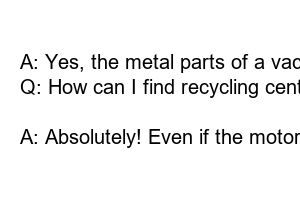청소기 버리는 법
Throwing away an old vacuum cleaner may seem like a straightforward task, but it’s important to dispose of it properly to minimize environmental impact. In this blog post, we will guide you through the process of throwing away a vacuum cleaner in an environmentally friendly manner.
1. **Evaluate the condition of your vacuum cleaner**: Before deciding to throw away your vacuum cleaner, consider whether it can be repaired or donated. If it’s beyond repair and not suitable for reuse, then it’s time to dispose of it.
To dispose of your vacuum cleaner responsibly, follow these steps:
2. **Check your local recycling regulations**: Different regions have varying recycling regulations, so it’s crucial to familiarize yourself with the rules in your area. Some municipalities may accept vacuum cleaners at curbside, while others may require you to drop them off at designated recycling centers.
3. **Remove any reusable parts**: Before recycling your vacuum cleaner, determine if any components can be salvaged for reuse. Certain parts like the motor or attachments may still have value. Consider selling or donating these parts separately to reduce waste.
4. **Disconnect and dispose of the power cord**: The power cord of your vacuum cleaner usually can’t be recycled alongside the appliance itself. To dispose of it responsibly, check local regulations for guidance. In some areas, power cords can be taken to electronic recycling centers or donated to organizations that repurpose or recycle electrical cords.
5. **Prepare your vacuum cleaner for recycling**: To ensure safe disposal, take precautions to protect yourself and any recycling professionals who handle the appliance. Empty the dust canister or bag and clean the vacuum thoroughly. If the vacuum has a battery, remove it and recycle it separately according to local guidelines.
6. **Find a recycling center or collection event**: Once your vacuum cleaner is ready for recycling, locate a recycling center that accepts small appliances like vacuums. Some centers may require an appointment or charge a fee, so it’s essential to confirm the details beforehand. Additionally, be on the lookout for collection events in your area where you can drop off your unwanted vacuum cleaner for recycling.
7. **Dispose of your vacuum cleaner at a recycling center**: Take your vacuum cleaner to the designated recycling center or event and follow their instructions for proper disposal. By recycling your vacuum cleaner, you are preventing it from ending up in a landfill and contributing to pollution.
In summary, disposing of a vacuum cleaner properly involves evaluating its condition, checking local recycling regulations, removing reusable parts, disconnecting and disposing of the power cord, preparing the vacuum cleaner for recycling, finding a recycling center or collection event, and ultimately disposing of it responsibly. By following these steps, you can ensure that your old vacuum cleaner is recycled and does not harm the environment.
FAQs:
Q: Can I throw my vacuum cleaner in the regular trash?
A: It’s best to avoid throwing your vacuum cleaner in regular trash, as it is not environmentally friendly. Look for recycling options instead.
Q: Can I donate my old vacuum cleaner?
A: If it’s still in working condition, consider donating it to a charitable organization or a second-hand store.
Q: Can I recycle the plastic parts of a vacuum cleaner?
A: Most plastic parts of a vacuum cleaner can be recycled. Look for recycling centers that accept small appliances.
Q: Can I recycle the metal parts of a vacuum cleaner?
A: Yes, the metal parts of a vacuum cleaner can usually be recycled. Check with your local recycling center for specific instructions.
Q: How can I find recycling centers near me?
A: You can search online for recycling centers in your area or consult your local waste management authority for guidance.
Q: Can I recycle a vacuum cleaner with a broken motor?
A: Absolutely! Even if the motor is broken, other parts of the vacuum cleaner can still be recycled. Remember to remove the battery if applicable.

